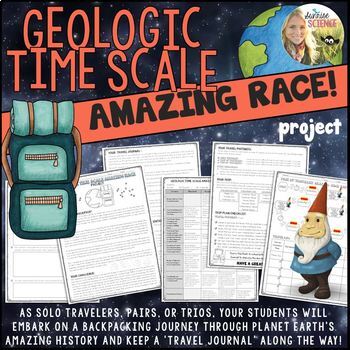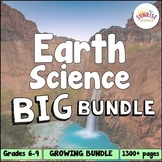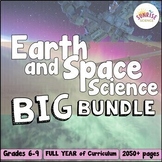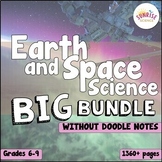Geologic Time Scale Research Project : Amazing Race
- Zip
What educators are saying
Also included in
- Looking for fun, student-centered, and engaging activities to add into your Earth Science curriculum? This is all of my resources for teaching Earth Science! This is a bundle of engaging resources including editable NGSS-aligned blended learning units, Cornell Doodle Notes, digital Pixel Art contentPrice $223.00Original Price $316.63Save $93.63
- This is a bundle of all of my resources for teaching Earth and Space Science at the middle school level! These resources include a mix of Cornell Doodle Notes, lab activities, inquiry activities, digital lessons and units, projects, and pixel art digital content review activities.✨ Please note thatPrice $327.00Original Price $450.24Save $123.24
- This Geologic Time bundle contains engaging, student-centered resources including a 3-week digital unit with assessments on the study of Geologic History and Geologic Time (perfect for blended learning classrooms in which your students engage in hands on activities alongside digital activities!), aPrice $38.00Original Price $47.90Save $9.90
- This is a bundle of all of my resources for teaching Earth and Space Science at the middle school level, EXCLUDING the Cornell Doodle Notes. The resources in this bundle include a mix of digital lessons and units, lab activities, inquiry activities, projects, review activities, and assessments.✨ ThiPrice $259.00Original Price $369.00Save $110.00
Description
Just as in the T.V. show “The Amazing Race” for which contestants travel around the world on a giant scavenger hunt, in this Geologic Time Scale Amazing Race project, your students will be embarking on a journey through time as they choose time periods to visit along Earth's Geologic Time Scale and collect information and evidence from each that will be used in modern times to learn about the past. They will follow a Travel Map and complete 'Time Travel Tasks' along the way that include Speed Bumps, Detours, and Fast Forwards! The required research includes climate, atmosphere, lifeforms, index fossils, continent locations and tectonic plate structure, major catastrophic and slow-moving events, and evidence that we use now to learn about the time period such as index fossils, radioactive elements, radiocarbon dating, impact craters, and geological formations.
Your students will be able to choose to travel alone, as a pair, or as a trio, but their challenge changes depending on their group size! Students will be keeping a ‘Travel Journal’ (research notes) during their trip. Each travel group size receives a specific Travel Map and Travel Log for their journey. A Start Here page is included, which has shortened links for a handful of great web resources where students can begin their research. Students record their research notes on Travel Journal Research Notes pages and collect Destination Flags. Then, they complete Travel Tasks to earn Roaming Gnomes for their Travel Log.
The culminating project is that the students must turn their research into a ‘Travel Journal’ presentation in the form of a Powerpoint or a Google Slides (if you have this option). This project will help the students to digest all of the information that they’ve discovered along their journey, and it will help them to understand the underlying principle of the Geologic Time Scale, which is that all of the recorded time is relative and these ‘periods’ were usually punctuated by major events. At least 2 slides per time period will showcase what students’ have learned. A minimum of 3 drawings or artist interpretations must be included for each time period. The directions specify that all resources, and at least 3, must be cited on a Works Cited slide in MLA format (with help from BibMe.org or EasyBib.com). You could have your students present their Travel Journal presentations to their class.
A ‘Teacher Key’ page is included that I hope will help you to quickly access information about each specific time period so that you can double-check your students’ research if necessary. A grading rubric is provided that assesses students’ final project and that they have included all of the required information as per the checklists.
This project translates nicely into a digital project if your students have access to personal devices, and the links to access the documents in Google are included. There are instructions for the teacher for facilitating this project digitally, including digital Roaming Gnomes and Destination Flags to add to students' Travel Maps, a digital time travel card choice board, student directions, research pages, "Start Here" research links, and travel journal template.
I have also included an editable version of the project pages because I know that sometimes you need to modify things for certain student groups.
This project is a student-centered project to align with the following NGSS Standards: MS-ESS1-4: Construct a scientific explanation based on evidence from rock strata for how the geologic time scale is used to organize Earth’s 4.6-billion-year-old history, MS-ESS2-2: Construct an explanation based on evidence for how geoscience processes have changed Earth’s surface at varying time and spatial scales, MS-ESS2-3: Analyze and interpret data on the distribution of fossils and rocks, continental shapes, and seafloor structures to provide evidence of the past plate motions, and MS-LS4-1: Analyze and interpret data for patterns in the fossil record that document the existence, diversity, extinction, and change of life forms throughout the history of life on Earth.
Haven't actually taught your students anything about Geologic Time or Geologic History yet? Take a look at these resources:
Geologic History Blended Learning Unit
Clay Cupcake Sedimentary Rock Strata Activity
Relative Dating of Rocks Doodle Notes
Geologic History Pixel Art Digital Vocabulary Review
Geologic History "Clue-Style" Review Board Game
Thanks for looking!
Sunrise Science









